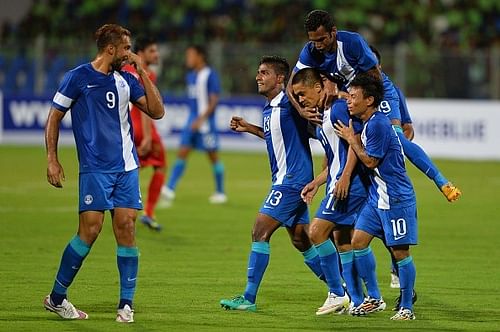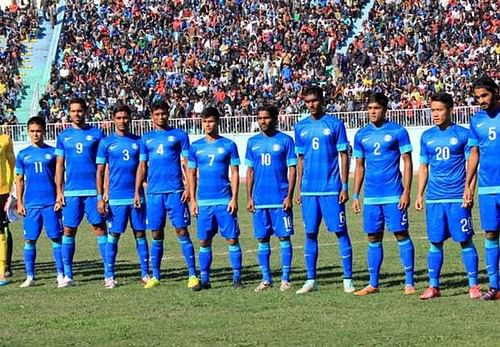
Indian football: A strange paradox

Indian football remains a strange paradox. The players are getting paid well, live in comfort and get top class training yet the performance of the national team is dismal. Despite lucrative money, exposure and training the Indian national team is languishing at the 157th position in the FIFA rankings. But in domestic football, the players make a lot of money.
At the first ever player auction of the Indian Super League (ISL) held on 10 July, 2015, the eight franchises spent in both the auction and the domestic draft, the grand sum of Rs. 27.29 crores. All the players in the auction were bought. India’s skipper and all time top-scorer Sunil Chettri with a base price of Rs. 80 lakhs was bought by Mumbai City FC for Rs. 1.2 crores.
Dynamic international midfielder Eugenson Lyngdoh (base price Rs. 27.50 lakhs) was purchased by FC Pune City for Rs. 1.05 crores. Indian football has become glamorous and popular, as foreign stars like Nicholas Anelka, Marco Materazzi, Helder Postiga, Simao Sabrosa and Roberto Carlos will play in the ISL, but the standard of Indian players is stagnant.
In the player’s draft for the 2nd ISL, to be held from October to December 2015, the highest amount was spent by Mumbai City FC on left back Keegan Pereira, who went for Rs. 32 lakhs. Another left back Gurjinder Kumar was picked up by Pune City FC for Rs. 27 lakhs. The lowest price was for striker Thongkhosiem Haokip, just Rs. 1.8 lakhs to FC Goa. Overall 18 midfielders were picked up in this draft. Chennaiyan FC paid the highest amount of Rs. 23 lakhs for Zakeer Mundampara whilst Delhi Dynamos got Zodingliana Ralte for just Rs. 2 lakhs
Yet despite such glamour and big money, the performance of the national team is unsatisfactory. In the 2014 Incheon Asian Games, India failed to score a goal in men’s football competition, losing 0-5 to UAE and 0-2 to Jordan.
In the 2018 World Cup qualifiers, India lost both their matches, at home to Oman 1-2 and away to Guam 1-2. India’s next World Cup qualifier is against Asia’s highest ranked team, Iran on September 8 in Bangalore. In October 2015, India plays away matches against Turkmenistan (Oct 8) and Oman (Oct. 13). Thus, India may lose their first five World Cup qualifiers and be eliminated from the competition.
India started playing World Cup qualifiers only in 1985 after pressure from FIFA but the overall performance is mediocre. Till now India has played 37 World Cup qualifying matches, won nine, drawn 11, lost 17, scored 40 and conceded 73 goals. The nine victories have mostly come against countries ranked lower than us.
India’s best win in World Cup qualifiers was on 8 April 2001. On that day, India had upset United Arab Emirates (UAE) 1-0 at Bangalore with Jules Alberto scoring the match winner in the 71st minute. For the first time, India had beaten a country (UAE) ranked sixty places ahead of them in pre-World Cup matches.
Otherwise, India's victories had been against lesser- ranked nations. In 1985, India twice beat Bangladesh 2-1 (home and away matches), in 1993, India notched up a 3-1 win against Hong Kong and in 1996 beat Philippines 2-0. Then on 18 February 2004, India beat Singapore 1-0 at Margao. That is the last time India has won a World Cup qualifier.
The current generation of Indian players has got ample exposure to international football and received top class training. The reigning ISL champions Atletico de Kolkata trained at Atletico Madrid. The Delhi Dynamos received help from Feyenoord and FC Pune City went for a pre-season to Fiorentina FC (Italy). Each of the eight franchises has a total purse of Rs. 5.50 crores for domestic players and a purse of Rs. 15.50 crores for international players.
The budget for the traditional clubs in the Hero I-League (India’s National league championships) is also impressive. Champions Mohun Bagan and runners up Bengaluru FC had budgets of Rs. 12—15 crores. There is no shortage of money and exposure for the top players in India. Yet they have struggled when playing international football.
In the 1950s and 60s, financial rewards were limited but many of India's top footballers were amongst the best in Asia. Jarnail Singh, ChuniGoswami, P.K. Banerjee, T. Balaram, Peter Thangaraj, Arun Ghosh, Noor Mohammed, Aziz, Altaf Ahmed and Yusuf Khan to name a few have played for the Asian All Stars XI.
Right back Sudhir Karmakar was chosen the Best Defender in Asia when India came third in the 1970 Bangkok Asian Games. Since 1982, India has hired ten foreign coaches but quality players have been very few. Thus there are few Indian heroes for the young players to emulate.

One of the reasons for this strange paradox could be that the game was widespread in India just after Independence. It was played in nearly all the states and there was massive competition. Nowadays talented footballers are emerging from only a few states and the talent pool is small.
The loss to the tiny island-state of Guam led to a massive hue and cry on how little India does to groom players. Current national coach, Stephen Constantine said, “The basic education of Indian footballers is poor as at junior level the coaching standards are not good.” His immediate remedy for this crisis is to allow overseas Indians or those holding a Person of Indian Origin (PIO) Card to play for the country. Michael Chopra who plays for Kerala Blasters in the ISL has joined the bandwagon and said he is willing to play for India.
Constantine admits that this is a short-term solution. Talking to the media, he said, “to compete internationally we require overseas Indian players who have been trained abroad. When India develops good youth development systems and grooms players this process can be stopped.”
Skipper Chettri only partially agreed when he said, “Getting overseas Indians will help but we shouldn’t forget that we need them because we couldn’t tap into our own talent pool. Also they have to be in a different league. There’s no point getting 20 to a camp who are like us.”
The proposal to get overseas Indians to represent the country (Constantine has identified about ten players) is popular on social media in the country. However there is a major roadblock as the Government of India only allows people who possess an Indian passport to represent the country in international sports events. There is a Supreme Court ruling to this effect, which in fact, prevented Vijay Amrthraj’s son Prakash from representing India in the Davis Cup some years ago.
The secretary of the All India Football Federation (AIFF) Kushal Das said, “We will request the Union Sports Ministry to review the rule and give us special permission.” However so far, nothing has happened and most AIFF officials believe that chances of an amendment in the rules are slim.
So what is the remedy? The focus now is on youth development. For decades most Indian outfits the popular Kolkata clubs, Mohun Bagan and East Bengal did very little. Mohun Bagan’s coach Sanjoy Sen admits this drawback when he said, “Proper youth development programmes should have started long back. It should not be done in a farcical manner.”
Of all the I-league clubs, only Pune FC runs a residential academy. Bengaluru FC, I-League winners in 2014, runs a non-residential football youth academy and football schools. New franchise Bharat FC based in Pune has embarked on an ambitious youth development programme. The eight ISL franchises have also to spend some money on youth development and grassroots training.
The grassroots are still tender but the way forward seems to be empowering the state associations. The All India Football Federation (AIFF) will appoint a technical officer (must possess an AFC “A” License) and marketing officer, who will be on FIFA’s payroll. They will have to embark on holistic development of football in each state, which as AIFF secretary Kushal Das says “will focus on grassroots, youth development and coach education.”
To start with Assam, Bengal, Delhi, Goa, Kerala, Mizoram and Maharashtra are being targeted. The focus is on a few states so that they can be carefully monitored. Previously age fudging and haphazard developmental activities in most states hindered development of Indian football.
The AIFF hopes that by this innovative programme they can develop football skills amongst lakhs of children all over India, which will later help some of them become quality professional players. Can this ambitious plan succeed? Time alone will provide the final answer.